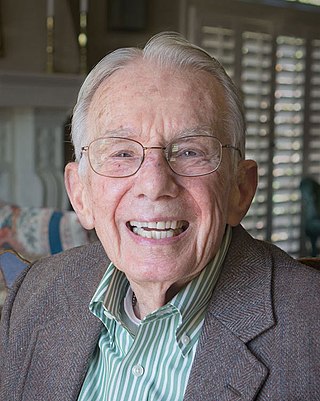Energy conservation is the effort to reduce wasteful energy consumption by using fewer energy services. This can be done by using energy more effectively or changing one's behavior to use less service. Energy conservation can be achieved through efficient energy use, which has a number of advantages, including a reduction in greenhouse gas emissions and a smaller carbon footprint, as well as cost, water, and energy savings.

The Energy Policy Act of 1992, effective October 24, 1992, is a United States government act. It was passed by Congress and set goals, created mandates, and amended utility laws to increase clean energy use and improve overall energy efficiency in the United States. The Act consists of twenty-seven titles detailing various measures designed to lessen the nation's dependence on imported energy, provide incentives for clean and renewable energy, and promote energy conservation in buildings.

Energy policy is the manner in which a given entity has decided to address issues of energy development including energy conversion, distribution and use as well as reduction of greenhouse gas emissions in order to contribute to climate change mitigation. The attributes of energy policy may include legislation, international treaties, incentives to investment, guidelines for energy conservation, taxation and other public policy techniques. Energy is a core component of modern economies. A functioning economy requires not only labor and capital but also energy, for manufacturing processes, transportation, communication, agriculture, and more. Energy planning is more detailed than energy policy.
Energy demand management, also known as demand-side management (DSM) or demand-side response (DSR), is the modification of consumer demand for energy through various methods such as financial incentives and behavioral change through education.

Arthur Hinton Rosenfeld was a UC Berkeley physicist and California energy commissioner, dubbed the "Godfather of Energy Efficiency", for developing new standards which helped improve energy efficiency in California and subsequently worldwide.

The energy policy of the United States is determined by federal, state, and local entities. It addresses issues of energy production, distribution, consumption, and modes of use, such as building codes, mileage standards, and commuting policies. Energy policy may be addressed via include legislation, regulation, court decisions, public participation, and other techniques.

The Alliance to Save Energy is a bipartisan, nonprofit coalition of business, government, environmental, and consumer groups based in Washington, D.C. The Alliance states that it advocates for "energy-efficiency policies that minimize costs to society and individual consumers, and that lessen greenhouse gas emissions and their impact on the global climate." The Alliance's chief activities include public relations, research, and lobbying to change U.S. energy policy.

The Energy Independence and Security Act of 2007, originally named the Clean Energy Act of 2007, is an Act of Congress concerning the energy policy of the United States. As part of the Democratic Party's 100-Hour Plan during the 110th Congress, it was introduced in the United States House of Representatives by Representative Nick Rahall of West Virginia, along with 198 cosponsors. Even though Rahall was 1 of only 4 Democrats to oppose the final bill, it passed in the House without amendment in January 2007. When the Act was introduced in the Senate in June 2007, it was combined with Senate Bill S. 1419: Renewable Fuels, Consumer Protection, and Energy Efficiency Act of 2007. This amended version passed the Senate on June 21, 2007. After further amendments and negotiation between the House and Senate, a revised bill passed both houses on December 18, 2007 and President Bush, a Republican, signed it into law on December 19, 2007, in response to his "Twenty in Ten" challenge to reduce gasoline consumption by 20% in 10 years.

Efficient energy use, sometimes simply called energy efficiency, is the process of reducing the amount of energy required to provide products and services. For example, insulating a building allows it to use less heating and cooling energy to achieve and maintain a thermal comfort. Installing light-emitting diode bulbs, fluorescent lighting, or natural skylight windows reduces the amount of energy required to attain the same level of illumination compared to using traditional incandescent light bulbs. Improvements in energy efficiency are generally achieved by adopting a more efficient technology or production process or by application of commonly accepted methods to reduce energy losses.
The American Solar Energy Society (ASES) is a non-profit 501(c)(3) organization advocating for renewable energy in the United States. Founded in 1954, ASES' goal is to speed the transition toward a sustainable energy economy and 100% renewable energy. The non-profit advocates on sustainable living and renewable energy issues in education, research and policy.
The Environmental and Energy Study Institute(EESI) is an independent, bi-partisan 501(c)(3) non-profit organization that aims to promote environmentally sustainable societies. Based out of Washington, DC, EESI seeks to be a catalyst moving society away from environmentally damaging fossil fuels and toward a clean energy future. The organization was established in 1984 by a bipartisan and bicameral group of members of the United States Congress who were concerned with global environmental and energy problems.

The United States is the second-largest single consumer of energy in the world. The U.S. Department of Energy categorizes national energy use in four broad sectors: transportation, residential, commercial, and industrial.
The Building Codes Assistance Project (BCAP) is a non-profit organization that advocates for the adoption, implementation, and advancement of building energy codes. It was established in 1994 as a joint initiative of the Alliance to Save Energy (ASE), the American Council for an Energy-Efficient Economy (ACEEE), and the Natural Resources Defense Council (NRDC). BCAP supports energy codes as a means to save money on energy bills, reduce energy consumption, lower greenhouse gas emissions, ensure occupant health and safety, create green jobs, and reduce the long-term impacts of the built environment.

The energy policy of the Obama administration was defined by an "all-of-the-above" approach which offered federal support for renewable energy deployment, increased domestic oil and gas extraction, and export of crude oil and natural gas. His presidency's first term was shaped by the failure of his signature climate legislation, the American Clean Energy and Security Act, to pass, and then climate and energy disasters including the Deepwater Horizon oil spill in 2010 and then Hurricane Sandy, which took place during the 2012 election. In his second term, Obama lifted the ban on crude oil exports and approved liquified natural gas exports; his planned regulatory approach to reducing greenhouse pollution in the electricity sector, the Clean Power Plan, was blocked by the U.S. Supreme Court.
A Deep energy retrofit can be broadly categorized as an energy conservation measure in an existing building also leading to an overall improvement in the building performance. While there is no exact definition for a deep energy retrofit, it can be defined as a whole-building analysis and construction process, that aims at achieving on-site energy use minimization in a building by 50% or more compared to the baseline energy use making use of existing technologies, materials and construction practices. Such a retrofit reaps multifold benefits beyond energy cost savings, unlike conventional energy retrofit. It may also involve remodeling the building to achieve a harmony in energy, indoor air quality, durability, and thermal comfort. An integrated project delivery method is recommended for a deep energy retrofit project. An over-time approach in a deep energy retrofitting project provides a solution to the large upfront costs problem in all-at-once execution of the project.
DERs are projects that create new, valuable assets from existing residences, by bringing homes into alignment with the expectations of the 21st century
Market transformation describes both a policy objective and a program strategy to promote the value and self-sustaining presence of energy-efficient technologies in the marketplace. It is a strategic process of market intervention which aims to alter market behavior by removing identified barriers and leveraging opportunities to further the internalization of cost-effective energy efficiency as a matter of standard practice. Market transformation has rapidly become the objective of many privately and publicly supported energy efficiency programs in the United States and other countries.

The World Resources Forum (WRF) is a non-profit organisation for sharing knowledge about the economic, political, social and environmental implications of global resource use. WRF promotes resource productivity among researchers, policymakers, business, NGOs and the public. In addition to organizing international and regional conferences, the WRF Secretariat coordinates multistakeholder dialogue projects, amongst others the Sustainable Recycling Initiative (SRI) as well as the H2020 projects Towards a World Forum on Raw Materials (FORAM), and CEWASTE. The WRF contributes to other EC-projects and projects with the German development organisation GiZ, UNEP and UNIDO.

CLASP is an international nonprofit organization which provides technical and policy support to governments worldwide and works to implement energy efficiency standards and labels (S&L) for appliances, lighting, and equipment. It specializes in publishing studies and analyses with relevance to S&L practitioners.
John A. "Skip" Laitner is an American-born economist, author and lecturer. He focuses on developing a more robust technology and behavioral characterization of energy efficiency resources for use in energy and climate economic policy models.
The Energy Conservation Program for Consumer Products Other Than Automobiles is a regulatory program that enforces minimum energy conservation standards for appliances and equipment in the United States. The program was established under Part B of Title III of the Energy Policy and Conservation Act of 1975 and gives the Department of Energy (DOE) the authority to develop and implement test procedures and minimum standards for more than 50 products covering residential, commercial and industrial, lighting, and plumbing applications. The Department of Energy is required to set standards that are "technologically feasible and economically justified."










